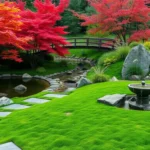We’ve all gazed at those stunning garden rockeries that effortlessly blend natural beauty with creative design, transforming ordinary outdoor spaces into captivating landscapes. Whether you’re working with a steep slope that needs taming or simply want to add visual interest to your yard, rockeries offer endless possibilities for both novice and experienced gardeners.
Rock gardens aren’t just about piling stones together—they’re about creating harmonious ecosystems where alpine plants thrive and water features flow naturally. From Mediterranean-inspired terraces to Japanese zen gardens, the right rockery design can become your garden’s stunning focal point while requiring minimal maintenance once established.
We’ll explore innovative ideas that work with any budget or space size, helping you discover how to select the perfect stones, choose drought-resistant plants, and design layouts that’ll make your neighbors stop and stare. Let’s transform your outdoor space into something truly extraordinary.
Choose the Perfect Location for Your Garden Rockery
Selecting the ideal spot for your rockery determines its long-term success and visual impact. Location affects everything from plant health to maintenance requirements throughout the seasons.
Consider Sunlight and Drainage Requirements
Sunlight exposure dictates which plants will thrive in your rockery space. Most alpine plants and succulents need 6-8 hours of direct sunlight daily to flourish. We recommend observing your yard throughout different times to identify areas that receive consistent morning and afternoon sun.
Drainage stands as the most critical factor for rockery success. Poor drainage kills more rock garden plants than harsh winters or droughts. Natural slopes provide excellent drainage, while flat areas often require additional soil amendments or raised construction. We suggest testing drainage by digging a 12-inch hole and filling it with water—if water remains after 24 hours, you’ll need to improve drainage conditions.
South-facing slopes offer optimal growing conditions for most rockery plants. These locations receive maximum sunlight while allowing excess moisture to drain naturally. East-facing areas work well for plants that prefer morning sun with afternoon shade protection.
Evaluate Slope and Natural Terrain Features
Existing slopes reduce construction time and create more natural-looking rockeries. Gentle grades between 15-30 degrees provide ideal conditions for rock placement and plant establishment. Steeper inclines may require terracing or retaining structures to prevent erosion.
Natural rock outcroppings serve as excellent starting points for rockery expansion. Building around existing stone formations creates authentic appearances while reducing material costs. We find that incorporating native stones maintains regional character and supports local wildlife habitats.
Soil composition varies significantly across different terrain features. Sandy or gravelly soils drain well but may need organic matter additions. Clay-heavy areas require extensive amendment with coarse sand, gravel, and compost to achieve proper drainage. Testing soil pH helps determine which plants will establish successfully.
Plan for Accessibility and Viewing Angles
Proximity to main walkways enhances daily enjoyment of your rockery display. Positioning rock gardens within 20-30 feet of patios, decks, or frequently used paths ensures regular appreciation of seasonal changes. Close placement also simplifies maintenance tasks like weeding and watering.
Multiple viewing perspectives create more ever-changing visual experiences. We design rockeries to look attractive from different angles rather than just one primary viewpoint. Curved edges and varied heights prevent flat, one-dimensional appearances that lose interest quickly.
Maintenance access determines long-term care success for your rock garden. Paths or stepping stones should allow comfortable reach to all planting areas without damaging surrounding plants. We recommend maintaining 18-24 inch spacing between major rock groupings for easy access during routine care activities.
Select the Right Rocks and Stones for Your Design

Choosing the perfect rocks and stones forms the foundation of any successful garden rockery design. Your selection will determine both the visual impact and long-term success of your alpine garden sanctuary.
Understand Different Rock Types and Their Characteristics
Boulders create dramatic focal points that anchor your entire rockery design. These massive stones help define spaces and provide natural windbreaks for delicate alpine plants. Position them strategically to establish the framework of your garden before adding smaller elements.
Pebbles and gravel add essential texture and visual interest throughout your rockery industry. These smaller materials fill gaps between larger rocks while providing excellent drainage for alpine plants. We recommend using pebbles ranging from 1/4 inch to 2 inches in diameter for optimal coverage.
Stepping stones invite exploration and create natural pathways through your rockery garden. These flat, stable rocks guide visitors while protecting delicate plants from foot traffic. Choose stones at least 18 inches wide to ensure comfortable stepping surfaces.
Irregular rocks offer authentic natural appeal that mimics mountain landscapes perfectly. Their unpredictable shapes create interesting shadows and planting pockets throughout your design. Select pieces with weathered surfaces to enhance the aged, natural appearance.
Smooth stones lend formal elegance to contemporary rockery designs. These polished materials work exceptionally well in modern garden settings where clean lines matter most. Combine them with architectural plants for sophisticated visual balance.
Mix Textures and Sizes for Visual Interest
Varying rock sizes creates ever-changing visual layers that keep viewers engaged throughout your garden space. Start with large boulders as anchor points, then fill surrounding areas with medium-sized rocks and finish with smaller pebbles for seamless transitions.
Contrasting textures add depth and complexity to your rockery design. Combine rough, weathered limestone with smooth river rocks to create compelling visual tension. This approach mimics natural mountain environments where different geological processes create diverse stone surfaces.
Strategic placement of different sized materials enhances your garden’s three-dimensional appeal. Place larger rocks at the base of slopes with progressively smaller stones moving upward. This technique creates natural-looking talus slopes that alpine plants love.
Color coordination between different rock types unifies your overall design scheme. Choose stones within the same color family but with varying textures to maintain visual cohesion. Earth tones like grays, browns, and muted reds work beautifully together.
Source Local Materials for Authentic Appeal
Local garden centers offer region-appropriate stone selections that naturally complement your area’s industry. These retailers understand local soil conditions and climate factors that affect rock performance. Visit multiple centers to compare quality and pricing before making large purchases.
Home improvement stores provide convenient access to bulk stone materials at competitive prices. Many locations offer delivery services for heavy materials, saving you transportation costs. Check their seasonal sales for important savings on rockery supplies.
Natural areas may provide authentic local stones if collection is legally permitted. Always obtain proper permissions before harvesting materials from public or private lands. This approach ensures your rocks blend seamlessly with surrounding native landscapes.
Quarries and stone yards offer the widest selection of high-quality materials for serious rockery projects. These specialized suppliers can provide detailed information about stone characteristics and recommend appropriate materials for your exact needs. Many offer custom cutting services for unique design requirements.
Create Stunning Multi-Level Rockery Designs

Multi-level rockeries transform flat or sloped gardens into ever-changing landscapes that catch the eye from every angle. These vertical designs maximize planting space while creating natural focal points throughout your outdoor area.
Build Terraced Rock Gardens for Sloped Areas
Slopes present incredible opportunities for creating breathtaking terraced rock gardens that prevent erosion while showcasing your plant collection. Natural inclines can be transformed into beautiful, multi-level displays by layering rocks and plants in strategic formations.
Start by creating distinct levels using large rocks as retaining walls for each terrace. Each level should be approximately 18-24 inches apart to allow proper plant growth and maintenance access. This terracing approach maximizes available space while adding dramatic visual interest to previously unusable sloped areas.
Choose materials that complement existing industry features for a cohesive appearance. Matching stone colors to nearby steps, patios, or other hardscape elements creates seamless transitions throughout your garden design.
Design Cascading Stone Arrangements
Water features elevate cascading stone arrangements into tranquil garden sanctuaries that engage multiple senses. Incorporating waterfalls or small streams creates natural flow patterns that enhance the peaceful atmosphere of your rockery.
Position rocks to mimic natural geological formations where water would naturally flow. This arrangement allows water to move smoothly over stone surfaces, creating gentle sounds that mask neighborhood noise while attracting beneficial wildlife.
Layer stones at varying heights to create multiple water drop points. Each level should feature slightly different stone sizes, with larger rocks anchoring the structure and smaller stones providing texture and visual detail.
Incorporate Natural-Looking Rock Formations
Local stone materials help rockeries blend seamlessly with surrounding landscapes while supporting regional wildlife habitats. Using indigenous rocks maintains authentic aesthetics that appear as though they’ve always belonged in your garden space.
Bury approximately one-third of each rock to achieve stable, natural-looking placements that withstand weather and time. This technique prevents shifting while creating the illusion that stones emerged naturally from the earth rather than being artificially placed.
Fill gaps between rocks using a specialized planting mix of loam, horticultural grit, and leaf mold for optimal plant health. This gritty mixture provides excellent drainage while supplying necessary nutrients for alpine plants and rock garden perennials to flourish.
Incorporate Water Features Into Your Rockery

Adding water elements transforms ordinary rock gardens into captivating landscapes that engage multiple senses. These aquatic features create natural cooling effects while providing habitat for beneficial wildlife.
Add Small Waterfalls and Streams
Small waterfalls bring movement and sound to your rockery design while creating focal points that draw the eye naturally upward. We recommend arranging rocks strategically to create natural water flow patterns that mimic mountain streams. Position larger stones at the top of your slope to serve as the waterfall’s source point.
Install a small recirculating pump system to maintain continuous water movement throughout your rock arrangement. Choose pumps with adjustable flow rates so you can control the water’s speed and sound level. Hide the pump mechanism behind larger boulders to maintain the natural appearance of your water feature.
Create multiple cascading levels by stacking flat stones at varying heights along your slope. Each level should catch and redirect water to the next tier below. This technique adds visual depth while maximizing the soothing sound of flowing water throughout your garden space.
Install Rock Pool Elements
Rock pools serve as stunning centerpieces that reflect surrounding plants and sky while creating habitats for aquatic life. We suggest positioning these water features at the base of slopes where natural water collection would occur. Excavate shallow basins approximately 18 to 24 inches deep for optimal plant and wildlife support.
Line your pool area with large flat stones that extend slightly over the water’s edge to create natural looking borders. Choose stones with interesting textures and colors that complement your existing rock selection. This overhang provides shelter for small amphibians and creates attractive reflection patterns on the water’s surface.
Add submerged rocks and boulders within the pool to create varying depths and provide platforms for aquatic plants. Position these elements asymmetrically to avoid artificial appearances. Include one or two larger statement rocks that break the water’s surface for added visual interest.
Create Moisture-Loving Plant Zones
Moisture-loving plant zones maximize the benefits of your water features while creating lush green backdrops for stone elements. We recommend establishing these planting areas within 3 to 5 feet of your water sources where soil naturally retains more moisture. Plants in these zones benefit from constant humidity and occasional water overflow during heavy rains.
Select plants that thrive in consistently moist conditions such as hostas, ferns, and astilbe varieties. These species create striking contrasts against hard stone surfaces while requiring minimal maintenance once established. Group plants with similar water requirements together to simplify care routines.
Position taller moisture-loving plants behind your water features to create natural screens and privacy barriers. Lower growing species work well along pool edges where they can trail gracefully into the water. This layered approach creates depth and maintains visual balance throughout your rockery design.
Plant Selection Strategies for Rock Gardens

Selecting the right plants transforms your rockery from a simple stone arrangement into a thriving network. We’ll guide you through strategic plant choices that ensure long-term success while maintaining the natural beauty of your alpine garden.
Choose Alpine and Drought-Tolerant Species
Alpine plants form the backbone of successful rock gardens because they’re naturally adapted to harsh growing conditions. Rock Soapwort (Saponaria ocymoides) thrives in USDA Hardiness Zones 2-11 with minimal watering requirements, producing bright pink flowers that bloom in early summer and cascade beautifully over rocks.
Sempervivum varieties, commonly known as house leeks, create stunning ground-covering mats in zones 3-8 while requiring virtually no maintenance during winter months. These hardy succulents store water in their thick leaves and multiply naturally to fill gaps between stones.
Euphorbia Firesticks (Euphorbia tirucalli ‘Sticks on Fire’) adds dramatic color to rockeries in zones 9-11 with vibrant orange and red stems that intensify in cooler weather. This succulent thrives in hot, dry conditions where other plants struggle to survive.
Drought-tolerant species reduce maintenance while providing consistent performance throughout challenging weather conditions. We recommend testing your soil drainage before planting since these species require excellent drainage to prevent root rot.
Plan for Year-Round Color and Interest
Evergreen conifers provide structural backbone and consistent color when flowering plants go dormant. Chamaecyparis ‘Blue Moon’ offers silvery-blue foliage that contrasts beautifully with warm-toned stones, while Pinus mugo ‘Gnom’ creates compact, rounded forms that anchor larger rock groupings.
Seasonal flowering schedules ensure continuous visual appeal throughout the growing season. Early spring bulbs like crocuses emerge between rocks, followed by summer perennials, and finally autumn-blooming sedums that provide late-season color.
Winter interest comes from plants with attractive bark, persistent seed heads, or colorful stems that stand out against snow and dormant landscapes. Strategic placement of these four-season plants creates focal points that draw the eye even during the dormant months.
Color progression planning involves selecting plants that bloom in succession rather than all at once. This approach maintains visual interest and prevents the garden from looking sparse during off-peak periods.
Consider Plant Size and Growth Habits
Low-growing plants like Sempervivum and Sedum varieties serve multiple functions as ground cover while helping hold soil together and prevent moisture loss between rocks. These mat-forming species spread naturally to fill spaces without overwhelming neighboring plants.
Tall plants including conifers and ornamental grasses add vertical interest and create natural focal points within the rockery design. Position these larger specimens strategically to balance the composition without blocking views of smaller alpine treasures.
Growth habit compatibility ensures plants won’t compete aggressively for space or resources. Clumping plants stay contained within their designated areas, while spreading varieties can fill larger spaces between major rock formations.
| Plant Category | Height Range | Spread | Maintenance Level |
|---|---|---|---|
| Ground Cover Alpines | 2-6 inches | 12-24 inches | Low |
| Medium Perennials | 6-18 inches | 8-16 inches | Medium |
| Tall Accent Plants | 18+ inches | 12-36 inches | Medium |
Mature size planning prevents overcrowding issues that develop over time as plants establish and spread. We space plants according to their ultimate size rather than their nursery pot dimensions to ensure long-term success.
Design Pathway Integration Within Your Rockery

Pathways transform our rockeries from static displays into captivating landscapes that invite exploration. We’ll create functional routes that enhance both the visual appeal and accessibility of our rock garden spaces.
Create Stepping Stone Walkways
Stepping stones provide clear navigation through our rockery while protecting surrounding plantings from foot traffic damage. We can design these walkways using varying stone sizes and shapes to add visual interest throughout the garden space. Natural flagstone works exceptionally well for this purpose, offering durability and authentic texture that complements alpine plantings.
Spacing becomes crucial when we position stepping stones, with 18 to 24 inches between centers creating comfortable strides for most visitors. We should embed each stone slightly into the ground to ensure stability and prevent wobbling during use. Irregular shapes and sizes create more organic pathways that feel naturally integrated within our rockery design.
Build Natural Rock Steps and Landings
Natural rock steps transform sloped terrain into functional and picturesque features within our garden rockery. We can construct these using larger stones as risers, with flat rocks serving as treads to create safe passage through elevation changes. Each step should measure 6 to 8 inches in height for comfortable navigation while maintaining visual proportions.
Landing areas between step sequences provide resting spots and prevent the pathway from feeling too steep or rushed. We’ll use broader, flatter stones for these platforms, ensuring they’re large enough to accommodate two people standing comfortably. Rock steps work particularly well when we integrate them with retaining walls, creating seamless transitions between different garden levels.
Stability requires proper foundation preparation, with each rock step set firmly into compacted soil or sand base. We can fill gaps between stones with smaller rocks or drought tolerant ground covers like Sedum varieties.
Design Meandering Gravel Paths
Gravel paths offer low maintenance answers that complement our rockery’s natural beauty while providing excellent drainage. We can create these pathways using decomposed granite, pea gravel, or crushed stone in colors that harmonize with our selected rocks. Path widths between 3 to 4 feet accommodate comfortable walking while maintaining intimate garden scale.
Curved routes feel more natural than straight lines, allowing us to wind around boulders and through planted areas. We’ll install edging materials like steel strips or larger stones to contain the gravel and maintain clean path boundaries. Proper base preparation involves excavating 3 to 4 inches deep and adding industry fabric to prevent weed growth.
Regular maintenance requires occasional raking to maintain smooth surfaces and adding fresh gravel annually to replace material lost to weather. We can enhance these paths by incorporating stepping stones at key points or installing subtle solar lighting for evening garden access.
Implement Proper Drainage Solutions

Effective drainage systems form the backbone of successful garden rockery projects. Poor drainage leads to plant death and structural damage that can destroy months of careful planning.
Install Underground Drainage Systems
French drains provide the most reliable solution for rockery water management. We recommend laying perforated pipes in trenches filled with gravel to create these effective underground systems. Water seeps naturally into the pipes and gets directed away from your precious alpine plants.
Trenches and riser systems offer another proven approach for complex drainage needs. Pipes placed strategically in trenches work alongside risers that bring excess water to the surface or redirect it to secondary drainage systems. This dual approach prevents water accumulation during heavy rainfall periods.
Underground drainage systems can integrate seamlessly with existing industry features. We suggest connecting them to French drains for enhanced efficiency and better long term performance. The investment in proper underground infrastructure pays dividends by protecting your entire rockery investment.
Use Gravel and Sand Layering Techniques
Layering creates the foundation for excellent rockery drainage using natural materials. Start with a generous layer of gravel or stones at the bottom of your rockery installation. Add a carefully measured layer of sand or quality soil mixture on top to support healthy plant growth.
Permeable materials like gravel and coarse sand allow water to pass through freely without creating waterlogged conditions. We prefer using materials that complement your chosen stone colors while maintaining superior drainage properties. Different gravel sizes create varying drainage rates to match exact plant requirements.
Strategic layering prevents soil compaction that often destroys drainage over time. The bottom gravel layer acts as a reservoir during dry periods while quickly draining excess moisture during wet seasons.
Prevent Water Pooling and Root Rot
Slope design ensures water flows away naturally from your rockery plants. We recommend creating gentle gradients that direct water toward designated drainage areas without causing erosion problems. Even slight slopes of 2-3% can dramatically improve water movement.
Drainage channels provide targeted water management for problem areas in your rockery. Create small channels or shallow ditches to direct water away from sensitive plants and prevent destructive root rot conditions. These channels can become attractive design elements when lined with decorative stones.
Proper plant positioning works alongside drainage infrastructure to prevent moisture related problems. We suggest placing water loving species near natural drainage outlets while positioning drought tolerant plants on higher, well drained sections of your rockery.
Add Decorative Elements and Focal Points

Strategic placement of decorative elements transforms a simple rock garden into a captivating industry feature. We’ll explore how to create visual interest through artistic arrangements and functional additions.
Incorporate Sculptural Rock Arrangements
Stack rocks creatively to form sculptural elements that add depth and visual interest throughout your rockery space. Building balanced cairns or artistic stone towers creates natural focal points that draw the eye upward and break horizontal sight lines. Position these sculptural stacks at key viewing angles to maximize their impact from different garden perspectives.
Combine sculptural rock arrangements with raked gravel to create a serene and zen-like atmosphere around your garden space. This Japanese-inspired design technique uses contrasting textures to highlight both the smooth gravel patterns and rough stone surfaces. Rake the gravel in flowing lines around your rock sculptures to create movement and visual rhythm that complements the static stone elements.
Arrange boulders strategically to guide viewers through your rockery while establishing natural gathering points. Place larger stones at irregular intervals to create an organic flow that mimics natural rock formations found in mountainous regions. These sculptural arrangements work best when they appear to emerge naturally from the industry rather than looking artificially placed.
Install Garden Art and Ornamental Features
Place garden statues or sculptures amidst the rocks to add a touch of artistry and personality to your rockery design. Metal sculptures weather beautifully outdoors and develop attractive patinas over time that complement natural stone colors. Position these art pieces where they’ll be discovered gradually as visitors explore your garden paths.
Install weatherproof ornamental features like ceramic vessels or stone carvings that enhance your rockery’s unique character. Choose pieces that reflect your personal style while harmonizing with the natural materials already present in your design. These decorative elements should feel integrated rather than imposed upon the industry.
Incorporate functional art pieces such as sundials or decorative planters that serve dual purposes within your rock garden layout. These ornamental features add visual interest while providing practical benefits like time keeping or additional planting opportunities. Select materials that will age gracefully alongside your stone elements for long-term aesthetic cohesion.
Create Seating Areas Within the Rockery
Incorporate natural rock steps to create a practical path and enhance the rugged charm of your garden design. These functional elements double as seating opportunities when designed with appropriate depth and height for comfortable use. Build steps using flat fieldstones or split boulders that blend seamlessly with your existing rock selections.
Designate areas for seating using natural stone benches or amongst strategically placed rocks to create inviting spaces for relaxation and garden enjoyment. Position seating to take advantage of the best views within your rockery while ensuring comfortable access from main pathways. These rest areas become natural gathering spots where visitors can appreciate your garden’s intricate details.
Design curved stone seating walls that follow the natural contours of your rockery while providing multiple seating options for groups. Build these features using the same stone types found elsewhere in your garden to maintain visual continuity throughout the space. Incorporate back support elements using taller stones placed behind seating areas for enhanced comfort during extended garden visits.
Maintain Your Garden Rockery Year-Round

Proper maintenance ensures your rockery remains vibrant and healthy throughout all seasons. We’ll guide you through essential year-round care practices that keep your rock garden thriving.
Seasonal Pruning and Plant Care
Timing pruning correctly maximizes plant health and appearance. We recommend pruning plants immediately after they finish blooming to maintain their natural shape and encourage robust new growth for the following season.
Fertilizing requirements vary significantly among rockery plants. Alpine plants and succulents typically require little to no fertilizer due to their adaptation to nutrient-poor soils, while other perennials benefit from seasonal fertilization during spring and early summer.
Watering schedules should adapt to seasonal changes. During hot summer months, we increase watering frequency for newly planted specimens while maintaining minimal irrigation for established drought-tolerant species like Sempervivum and Euphorbia Firesticks.
Deadheading spent flowers promotes continuous blooming. Remove faded blooms from Rock Soapwort and other flowering alpines throughout the growing season to encourage repeat flowering and prevent unwanted self-seeding.
Weed Control and Rock Repositioning
Preventing weeds starts with proper ground coverage techniques. We place smaller stones or gravel around larger rocks to create a natural mulch that suppresses weed growth while unifying the overall design aesthetic.
Regular inspection helps identify problem areas early. Check for weeds monthly during growing season, removing them by hand to avoid disturbing shallow-rooted alpine plants nearby.
Repositioning rocks maintains both function and beauty. Occasionally adjust rock placement to ensure proper drainage patterns remain intact and the natural appearance stays authentic as plants mature and spread.
Gravel pathway maintenance requires seasonal attention. Rake and refresh gravel paths every few months to maintain their crisp appearance and prevent weed establishment in high-traffic areas.
Winter Protection and Spring Cleanup
Protecting vulnerable plants prevents winter damage. We apply mulch or cover tender alpine species during harsh winter conditions to shield them from frost damage and extreme temperature fluctuations.
Spring cleanup prepares the garden for new growth. Remove dead plant material, fallen leaves, and accumulated debris in early spring before new shoots emerge from dormant plants.
Drainage assessment becomes crucial after winter. Check that water flows properly through drainage channels and around rock formations, clearing any blockages caused by winter debris or settled soil.
Rock stability requires post-winter evaluation. Inspect larger rocks and stepping stones for movement caused by freeze-thaw cycles, repositioning them as needed to maintain safety and structural integrity.
Conclusion
Creating a stunning garden rockery transforms your outdoor space into a living masterpiece that combines natural beauty with practical functionality. We’ve shown you how proper planning drainage answers and thoughtful plant selection work together to build sustainable rock gardens that thrive year-round.
Your rockery journey doesn’t end with installation – it’s an ongoing relationship that rewards consistent care with spectacular results. The techniques we’ve shared will help you create a low-maintenance industry that supports local wildlife while providing endless visual interest.
Whether you’re working with a small corner or an expansive slope we’re confident these proven strategies will help you design a rockery that reflects your personal style. Start with one section and gradually expand as you gain experience and confidence in your rock gardening skills.
Frequently Asked Questions
What is a garden rockery and how is it different from regular rock arrangements?
A garden rockery is a carefully designed landscape feature that creates balanced ecosystems supporting alpine plants and natural water features. Unlike simple rock stacking, rockeries integrate stones, drought-resistant plants, and proper drainage to form sustainable, visually appealing garden spaces that mimic natural mountain environments.
What location factors should I consider when planning a rockery?
Choose locations with 6-8 hours of direct sunlight and excellent drainage, as most alpine plants require these conditions. South-facing slopes are ideal for optimal growth. Test drainage by digging holes and observing water absorption. Consider accessibility for maintenance and position near walkways for regular appreciation.
What types of rocks and stones work best for rockeries?
Use a mix of boulders for focal points, pebbles for texture and drainage, and stepping stones for pathways. Combine different textures and sizes for visual interest while maintaining color coordination. Source local materials from garden centers, quarries, or home improvement stores for authenticity and better integration with your landscape.
How do I create multi-level rockery designs?
Build terraced sections using large rocks as retaining walls to prevent erosion on slopes. Create cascading stone arrangements that mimic natural geological formations, layering stones at varying heights. This maximizes planting space, creates natural focal points, and transforms flat gardens into dynamic landscapes.
Can I incorporate water features into my rockery?
Yes, water features like small waterfalls and rock pools enhance the sensory experience. Use recirculating pump systems for water movement and create cascading levels for visual depth and sound. Position moisture-loving plants near water sources to create lush backdrops and improve the ecosystem balance.
What plants work best in rock gardens?
Choose alpine and drought-tolerant species like Rock Soapwort, Sempervivum, and Euphorbia Firesticks that thrive in various USDA Hardiness Zones. Include evergreen conifers for year-round structure and seasonal flowering plants for continuous color. Consider mature plant sizes to prevent overcrowding and maintain balanced composition.
How do I create pathways through my rockery?
Design stepping stone walkways using natural flagstone for durability and protection of plantings. Build natural rock steps and landings for sloped areas, ensuring safety and aesthetic appeal. Consider meandering gravel paths for low maintenance and excellent drainage with proper base preparation.
What drainage solutions are essential for rockeries?
Install underground drainage systems like French drains to prevent water accumulation and plant death. Use gravel and sand layering techniques to create foundations with excellent drainage. Design gentle slopes and drainage channels to direct water away from sensitive plants, preventing root rot issues.
How can I add decorative elements to enhance my rockery?
Incorporate sculptural rock arrangements like balanced cairns and artistic stone towers as focal points. Add raked gravel for Japanese-inspired serenity, install weatherproof garden art, and create natural stone seating areas. These elements add personality while maintaining the rockery’s natural aesthetic.
What maintenance does a rockery require throughout the year?
Perform seasonal pruning and adjust watering schedules based on weather conditions. Control weeds regularly, reposition loose rocks, and provide winter protection for vulnerable plants. Conduct spring cleanup to remove debris and prepare for new growth while ensuring proper drainage and rock stability.











